The Vintage Mac Museum is a private, working collection of the pre-Intel Apple Macintosh: 68k and PowerPC Macinti, old Mac software, period advertising and memorabilia. The VMM website has just undergone an extensive revision and expansion, designed to create both a virtual museum and a compilation of resources to help find information about old Mac hardware and software. The revised site has been organized around three major themes – Collection, Services and Resources.
 The biggest visual change is a beautiful new graphic design and back-end conversion to WordPress. Using a content management system allows for easy updating, correct formatting on mobile phones, and the merging of the main website with the Vintage Mac Museum Blog. The blog was formerly hosted on Blogspot, and all previous posts and comments have been migrated to the new site.
The biggest visual change is a beautiful new graphic design and back-end conversion to WordPress. Using a content management system allows for easy updating, correct formatting on mobile phones, and the merging of the main website with the Vintage Mac Museum Blog. The blog was formerly hosted on Blogspot, and all previous posts and comments have been migrated to the new site.
With this change we’ve embraced the classic Macintosh style graphics with a brand new VMM Logo, envisioning the Mac Finder icon done in the timeless Picasso style. It’s simple, vintage, and very Macintosh! My little contribution to the rich graphical world of Apple…
The Collection pages (68k Macintosh, PowerPC Beige, PowerPC G-Series, PowerBook) carry over from the previous site and describe the Museum’s possessions in a chronological story-of-Macintosh style. The Services section focuses on commercial areas of specialty for the Museum: vintage Mac file transfers & conversions, along with patent-related legal research finding prior art for technology related litigation. The Resources section is designed to be a growing reference for information about vintage Macs, as befits a Museum dedicated to the topic. Many links to Macintosh information, history and software downloads are available now, with more to come.
To enchance the Virtual Museum experience, pictures of the collection’s equipment and memorabilia have been interspersed throughout the site, with high resolution photos now available via popup links. Video links to classic Mac and Apple advertisements, formerly on a separate VMM TV YouTube page, now also play via in-site popups.
The 2013 site expansion, logo design and WordPress conversion was done in collaboration with Chelsea O’Brien at Tech Diva Media. I highly recommend the talents of Chelsea and her team for your web design, SEO and internet marketing needs!
Check it out, look around, and Say Hello Again!
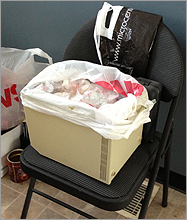 Between donations and purchases for the Vintage Mac Museum, I wind up with a fair amount of spare parts. I try to keep things in the rooms already dedicated for my Museum or up in the attic, but overage tends to spill out around the house.
Between donations and purchases for the Vintage Mac Museum, I wind up with a fair amount of spare parts. I try to keep things in the rooms already dedicated for my Museum or up in the attic, but overage tends to spill out around the house.
Recently I picked up a Mac Plus off craigslist to use as a parts machine. The owner had done several upgrades on the system over the years, and the rear case had some holes and taped over cracks on the inside. I was intending to just toss this piece out with the trash, but it spent a few weeks in the kitchen while I waited for February snowdrifts to melt outside.
Soon it acquired a new use, as a place to store plastic bags waiting for a trip to recycling. Not really a planned use, and not the kind of thing that most people have in their kitchens, but the rear case actually makes a good little trashcan. That’s kind of sad given its original purpose, but hey, this in itself is a form of recycling! :)
Or it proves that I have more Macs around than I know what to do with…
I recently received a request for help from a research group who had an old Macintosh file they couldn’t open. The file was created in the late 1980s in a statistical research program, but they couldn’t extract the contents no matter what they tried. The data was not stored in text format, and the file had developed a case of amnesia: it didn’t know what it was, and no software could recognize it.
 Old Mac files contain two embedded strings, called Type and Creator codes, which tell the Mac OS what kind of file it is and which program was used to create it. An equivalent kind of file type identification is used in most operating systems (including Mac OS X) in the form of a three character extension after the filename, e.g., filename.txt. This embedded data was missing on my client’s file, which is not uncommon when files have been copied across multiple disks and platforms over many years.
Old Mac files contain two embedded strings, called Type and Creator codes, which tell the Mac OS what kind of file it is and which program was used to create it. An equivalent kind of file type identification is used in most operating systems (including Mac OS X) in the form of a three character extension after the filename, e.g., filename.txt. This embedded data was missing on my client’s file, which is not uncommon when files have been copied across multiple disks and platforms over many years.
My client thought the file was originally created in a program called StatView. I found an archived copy of the software online at the Macintosh Garden (a great resource for Mac Abandonware), and tried to open the file. No go. I also tried some other statistics programs I have around for good measure, but nothing worked.
Next I launched Statview again and created a couple of test files, in both the “StatView4.1” and “old StatView” formats. This creates samples which contain the correct type/creator codes. Using File Buddy – another venerable old utility – I applied these codes to copies of the original file, then tried to open the copies. The file tagged as “old StatView” did the trick and opened no problem. Sweet. From there it was easy to export the data in text format (TSV), then import into Excel for use with modern computers.
For a situation like this it helps to have some guess as to the original software used. Creating sample files in various formats is a helpful way to apply educated guesses about missing type/creator codes to other amnesiac files – assuming you can find a copy of the software in the first place.
My client was thrilled to hear the news, they’d been working on this file for some time and had already gone down several dead ends. I asked what the data was for, and was told the following:
The data is from a European researcher. I am conducting what is called a “systematic review” which involves looking at every piece of data in a given area, in this case, vegetarian diets and weight loss. If I do not incorporate all the data (even those kept in old software in a foreign language) then my findings would not be considered complete.
You’ve saved science!
Nice. It’s not every day one gets to save science. Vintage Macs to the rescue!
Posted on February 14th, 2013 in
Vintage Mac Museum Blog |
4 Comments »
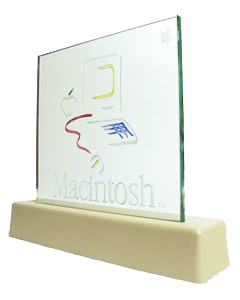 During rollout of the Macintosh back in 1984, Apple produced a limited edition promotional sign for the original Mac dealers. The sign has the now-famous Picasso line art along with the name Macintosh etched into a 10″ x 10″ piece of glass, manually beveled and painted. The glass was mounted on a beige plastic base containing an internal flourescent light, illuminating the glass from below. When switched on the sign sparkles like crystal and clearly announces that something new has arrived.
During rollout of the Macintosh back in 1984, Apple produced a limited edition promotional sign for the original Mac dealers. The sign has the now-famous Picasso line art along with the name Macintosh etched into a 10″ x 10″ piece of glass, manually beveled and painted. The glass was mounted on a beige plastic base containing an internal flourescent light, illuminating the glass from below. When switched on the sign sparkles like crystal and clearly announces that something new has arrived.
It’s difficult to find out much information about these signs, other than that they were produced for the original Mac dealers. There’s no record about who built the signs or how many were produced. Apparently each dealer was alloted only one sign. eBay auction listings have speculated between 25 and 1000 units produced, but the only solid info I found was part of Stanford’s Making the Mac archive.
The Macintosh Product Introduction Plan noted that there were 1500 Apple dealers total at the time of the Mac’s launch:
5.C Retail Introduction Plan
(b) reinforcing our commitment to our existing dealer base by offering to all 1500 current Apple dealers the opportunity to carry Macintosh. To become an authorized Macintosh dealer one must simply be a current dealer in good standing (exceptions will be determined by Sales & Sales Operations) and send a key Retail Sales Person (RSP) to be trained on Macintosh prior to public introduction.
Not all of those dealers carried the Mac, but at least half were apparently scheduled to receive a videodisc-based kiosk to help demo the product:
This demo-station will eventually be made available to all 1500 Apple dealers. Upon Macintosh introduction, at least 750 dealers will be stocked, additional dealers stocked subject to availability of videodisk players.
So an educated guess is somewhere around 750-1000 signs were made, with no more than 1500 tops. **
I wonder if those kiosks were actually produced?
The sign I have in the Vintage Mac Museum is working and in good condition. The paint has faded a bit after nearly thirty years in the field, but nevertheless the effect when lit is literally breathtaking. A gorgeous piece promotional media turned folk art, and something I’m proud to have in my collection!
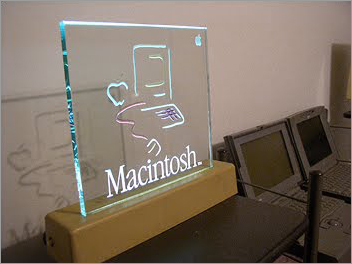
** Update Dec 2016: since initially writing this post (in 2012) I’ve seen quite a few of these signs for sale on eBay, leading me to suspect that the 1500 estimate is probably too low. Recently developer Don Burtis included the following notes on eBay about how he obtained his, which supports this contention:
I received this sign as a token of Apple’s appreciation for the hardware and software design my company did that benefited the Macintosh computer… I have no firm data how many signs might have been produced, but I’d guess it to be closer to 2500 rather than 1500. More signs must have been produced since Apple expected the dealer base to grow, replacements for broken signs must have been planned, some signs were used internally at Apple, and signs were given to some developers (such as me).
Burtis also noted that the signs were produced by Moonglow, Inc. of Fountain Valley, CA based on stickers on the bottom, but the company cannot be found today under that name. Too bad, it would definitely be nice to have more information about this iconic Apple item.
Posted on December 25th, 2012 in
Vintage Mac Museum Blog |
21 Comments »
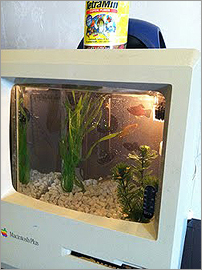 A few years back I purchased a Macquarium on eBay, one actually sold as a kit rather than a DIY project. All the little pieces of the case internally which needed to be cut or trimmed were already cut and trimmed, and the kit included a plexiglass tank, pump, heater, light and some fake plants. Just add gravel, water and fish!
A few years back I purchased a Macquarium on eBay, one actually sold as a kit rather than a DIY project. All the little pieces of the case internally which needed to be cut or trimmed were already cut and trimmed, and the kit included a plexiglass tank, pump, heater, light and some fake plants. Just add gravel, water and fish!
Like other projects at the Vintage Mac Museum this one was proceeding slowly, the empty assemblage had been sitting in my front foyer for some time. It occasionally elicited questions from visitors, requiring my explaining how a Macquarium worked. I’ve had more clients coming to my house recently to drop off items so I decided it was time to actually get the thing working.
A friend with more acquarium savvy than I agreed to assist. We cleaned everything, added water and gravel, and let the tank condition for a day. With this classic style Macquarium access to the tank was tight – just a small opening in the top rear where the handle had been cut away. Any other adjustments required removing the front bezel and sliding the tank forward. This proved to be more than a minor inconvenience in the days to come.
The next day I went to the pet store and picked up some fish. The tank is about 5.5 gallons. My friend recommended just one or two fish, but that seemed potentially lonely to me for the critters. At the pet store they said a tank that size could hold 5-8 fish, which makes things more interesting. I picked up five little guppie and zebra-fish types, and introduced them to their new home.
That first day all went well. How cool was it to have real live fish swimming around inside an old Mac case! I liked the bubbling sound of the undergravel filter. Life was good. Take that After Dark!
I awoke the following morning to a somewhat cloudy tank. By evening the cloudiness had increased. I thought perhaps the carbon pack in the old filter was expired and needed replacement, so I bought a fresh one. No difference. By the third day things were really getting murky.
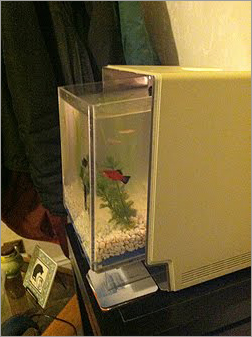
OK next step – try a new filter, this time a small one which hangs from the side of the tank and is submersible. It’s rated for up to a 10 gallon tank. That blocked some of the access space in the top rear of the case, but was still maneagable. However sliding the tank in and out to make these continued changes was getting to be a pain. I decided to leave the Mac faceplate cover off so I didn’t need to keep removing it.
Another day or two goes by, and there’s no improvement in water quality. It’s now a brownish soup and I’m beginning to worry for the health of the fish. I start siphoning out a bit of water every few hours and replacing with fresh, to help dilute the waste. That doesn’t really seem to make much difference.
Well, maybe this filter just doesn’t work correctly either. One more trip to the pet store to get another, larger filter. I repeat the tank removal/reinstall process. This larger filter barely fits in the tank, and creates a stream of water so strong that it shoots the fish around inside the tank. Sigh. After two hours I removed it and put the older submersible filter back.
One final attempt: start fresh. I put the fish and some existing water into a small container, then dumped the old water, cleaned the tank and gravel in the sink, and refilled with fresh warm water. I waited a few hours for the tank to settle and get to the right temperature, then put the fish back in.
They seemed OK. It had been a long few days for the acquatic ones. Not knowing whether I just solved the problem or delayed a repeat, I did some work elsewhere for a few hours, then returned to the tank.
Four fish were floating on top or bottom. The remaining one was barely twitching. What happened??? I thought it was just too much water-changing shock, but then noticed the light for the heater was not glowing (green or red). I poked a finger into the tank, and the water was noticeably colder than before.
The heater had failed.
After all that – three filters and multiple water changes – the damn heater craps out without warning? Now I’m not sure which shock killed the fish. But the experiment is over. I’m out of energy, and the fish are dead.
I washed out the tank again and set everything aside. Lessons learned:
– this aquarium thing is not as easy as it looks
– a classic Mac looks cool as a Macquarium, but the design is not optimal
– next time I’ll start with just one or two fish (if there’s a next time)
– maybe the After Dark fish module isn’t a bad solution after all!
 One of the charms of working with old Macs and their associated data are the periodic glimpses of simpler computing times past. These include intricately decorated floppy disk labels, personalized naming schemes, and cute folder graphics. Who didn’t have a set of the Simpsons icons?
One of the charms of working with old Macs and their associated data are the periodic glimpses of simpler computing times past. These include intricately decorated floppy disk labels, personalized naming schemes, and cute folder graphics. Who didn’t have a set of the Simpsons icons?
Recently I received a set of floppy disks containing the contents of a old book. It was written twenty years ago in Microsoft Word on a Mac Plus, and the writer’s family was looking to convert the files into something current. Along with the disks was a copy of a letter written by the author to the publisher, which really brought back memories of computing in the early 1990s:
September 1992
I trust by now you have received the two disks I mailed to you. The reason for the delay was the fact we had only one Master disk needed to boot up the “Book disk” and all our own data as well. In order to send it to you we first had to order a new program (MicroSoft doesn’t make our old program anymore) and then change over all our data to the new disk. Not too easy and it all took time.
I don’t know if you have worked on the Macintosh Plus, which is our computer, but the Book is set up with the Bookman type. We use a Lazer Printer that spews out camera-ready copy for you to give to the offset printer. If you find you need the whole book printed out by us before sending it to the book printer, please feel free to send it back to us.
You will notice on the disk that the book is divided into sections by page numbers. This is simply to give our printer a breathing space and time to cool down between sections. If you crash the whole program, never fear, we made a copy before sending it to you.
Ah yes – waiting to let the printer cool down! How true it was. If you printed more than a few dozen pages in a row on any of those early desktop units they might shut down as a self-protection mechanism. And there was a time when your System Folder, word processing program and documents were all on a single floppy disk.
Incidentally, I believe you can use the Microsoft program on any Macintosh. We had to buy a hard drive in order to do the book, but we have been delighted to have it anyway.
Kids today just don’t know how easy they have things…
Posted on September 15th, 2012 in
Vintage Mac Museum Blog |
1 Comment »
 The biggest visual change is a beautiful new graphic design and back-end conversion to WordPress. Using a content management system allows for easy updating, correct formatting on mobile phones, and the merging of the main website with the Vintage Mac Museum Blog. The blog was formerly hosted on Blogspot, and all previous posts and comments have been migrated to the new site.
The biggest visual change is a beautiful new graphic design and back-end conversion to WordPress. Using a content management system allows for easy updating, correct formatting on mobile phones, and the merging of the main website with the Vintage Mac Museum Blog. The blog was formerly hosted on Blogspot, and all previous posts and comments have been migrated to the new site.
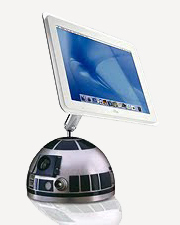
 Between donations and purchases for the Vintage Mac Museum, I wind up with a fair amount of spare parts. I try to keep things in the rooms already dedicated for my Museum or up in the attic, but overage tends to spill out around the house.
Between donations and purchases for the Vintage Mac Museum, I wind up with a fair amount of spare parts. I try to keep things in the rooms already dedicated for my Museum or up in the attic, but overage tends to spill out around the house. Old Mac files contain two embedded strings, called
Old Mac files contain two embedded strings, called  During rollout of the Macintosh back in 1984, Apple produced a limited edition promotional sign for the original Mac dealers. The sign has the now-famous Picasso line art along with the name Macintosh etched into a 10″ x 10″ piece of glass, manually beveled and painted. The glass was mounted on a beige plastic base containing an internal flourescent light, illuminating the glass from below. When switched on the sign sparkles like crystal and clearly announces that something new has arrived.
During rollout of the Macintosh back in 1984, Apple produced a limited edition promotional sign for the original Mac dealers. The sign has the now-famous Picasso line art along with the name Macintosh etched into a 10″ x 10″ piece of glass, manually beveled and painted. The glass was mounted on a beige plastic base containing an internal flourescent light, illuminating the glass from below. When switched on the sign sparkles like crystal and clearly announces that something new has arrived.
 A few years back I purchased a
A few years back I purchased a 
 One of the charms of working with old Macs and their associated data are the periodic glimpses of simpler computing times past. These include intricately decorated floppy disk labels, personalized naming schemes, and cute folder graphics. Who didn’t have a set of the Simpsons icons?
One of the charms of working with old Macs and their associated data are the periodic glimpses of simpler computing times past. These include intricately decorated floppy disk labels, personalized naming schemes, and cute folder graphics. Who didn’t have a set of the Simpsons icons?